How To Decorate A Living Room Farmhouse Style
Farmhouse style decor creates a warm, inviting, and relaxed atmosphere, evoking a sense of rustic charm and comfortable simplicity. Achieving this aesthetic in a living room involves a careful blend of natural materials, vintage accents, and a neutral color palette.
Establishing a Neutral Base: The foundation of farmhouse style lies in its color scheme. Walls are typically painted in neutral shades such as white, cream, beige, or light gray. These colors create a sense of airiness and allow other elements, like furniture and decor, to stand out. Soft, muted tones also contribute to the overall calming and welcoming ambiance.
Incorporating Natural Materials: Natural materials play a crucial role in achieving the authentic farmhouse look. Wood, particularly reclaimed or distressed wood, is a staple. It can be incorporated through flooring, exposed beams, furniture, and decorative accents. Stone, like shiplap or brick, can be used for accent walls or fireplaces, adding texture and visual interest. Natural fibers like cotton, linen, and jute are ideal for upholstery, rugs, and throw pillows, enhancing the room's cozy and organic feel.
Selecting Furniture with Character: Farmhouse furniture often features simple lines and a slightly weathered or distressed appearance. Sofas and armchairs with slipcovers in neutral fabrics like linen or cotton create a comfortable and inviting seating area. A wooden coffee table, perhaps with a distressed finish or metal accents, can serve as a focal point. Consider incorporating a vintage or antique piece, such as a repurposed cabinet or chest, to add character and a sense of history.
Utilizing Shiplap and Exposed Beams: Shiplap walls are a hallmark of farmhouse style, adding texture and visual appeal. This classic wall treatment can be used as an accent wall or throughout the entire room. Exposed wooden beams, whether original to the house or added for decorative purposes, contribute to the rustic and architectural character, bringing a sense of warmth and history to the space.
Layering Textures with Textiles: Layering textiles adds depth and warmth to the farmhouse living room. Throws draped over sofas and armchairs, woven rugs, and textured cushions contribute to the overall cozy and inviting atmosphere. Consider using natural fiber textiles like cotton, linen, wool, and jute for an authentic touch. Incorporating subtle patterns like stripes, checks, or florals can add visual interest while maintaining a cohesive look.
Accessorizing with Vintage and Rustic Touches: Vintage and antique finds are essential for completing the farmhouse look. These can include items such as old signs, vintage clocks, enamelware, or repurposed farm tools. Adding these elements introduces a sense of history and personality to the space. Rustic accents, such as metal buckets, wire baskets, and galvanized steel containers, can be used for storage or as decorative elements, further enhancing the farmhouse aesthetic.
Emphasizing Functionality and Practicality: Farmhouse style prioritizes functionality and practicality. Furniture pieces are chosen for their comfort and durability. Storage solutions, such as open shelving or baskets, are incorporated to keep the space organized and clutter-free. The overall design aims to create a living room that is both aesthetically pleasing and comfortable for everyday living.
Introducing Greenery and Natural Elements: Incorporating plants and other natural elements further enhances the farmhouse aesthetic. Potted plants, fresh flowers, branches, or dried floral arrangements add a touch of life and color to the room. Consider using vintage or repurposed containers for displaying plants, such as metal buckets or enamelware pitchers. This connection to nature reinforces the farmhouse style's emphasis on simplicity and organic living.
Lighting Considerations for a Warm Ambiance: Lighting plays a significant role in creating the desired atmosphere in a farmhouse living room. Natural light is maximized through the use of sheer curtains or blinds. For artificial lighting, consider using a combination of ambient, task, and accent lighting. Wrought iron chandeliers or pendant lights can serve as a focal point, while table lamps and floor lamps provide softer, more localized lighting. Warm-toned light bulbs contribute to the overall cozy and inviting ambiance.
Creating a Cozy and Inviting Fireplace Focal Point: A fireplace, if present, can serve as a natural focal point in a farmhouse living room. Decorating the mantel with vintage or rustic accents, such as candles, framed prints, or seasonal decor, enhances the farmhouse charm. Consider using a fireplace screen with a wrought iron or distressed wood frame. The fireplace area can be further enhanced by arranging comfortable seating nearby, creating a cozy and inviting gathering space.
Maintaining a Balance of Old and New: Achieving a successful farmhouse style involves striking a balance between old and new elements. While vintage and antique pieces add character and history, incorporating modern pieces prevents the space from feeling overly themed or dated. This balance ensures a fresh and contemporary feel while retaining the core elements of farmhouse charm.

30 Farmhouse Living Room Ideas Cozy

The 60 Best Farmhouse Living Room Ideas Homegue Decor Farm House Modern

Our Home Tour Farm House Living Room Farmhouse Decor Curtains

25 Modern Farmhouse Living Room Decor Ideas Farm House

30 Modern Farmhouse Living Room Ideas That Are Effortlessly Cool Completely Doable Décor Aid

Thrifty And Chic Diy Projects Home Decor

30 Farmhouse Living Room Ideas Cozy

15 Gorgeous Farmhouse Decor Ideas For Your Living Room The Unlikely Hostess

28 Cozy Living Room Farmhouse Wall Decor Ideas

Farmhouse Living Room Tour Cozy And Inviting Ideas
Related Posts







